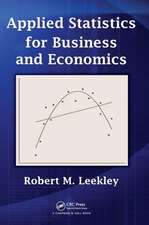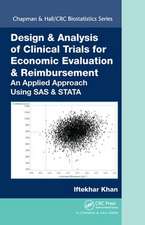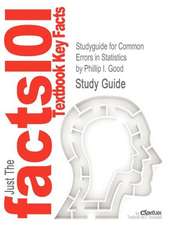A Practitioner’s Guide to Resampling for Data Analysis, Data Mining, and Modeling
Autor Phillip Gooden Limba Engleză Hardback – 25 aug 2011
Highlights
- Each chapter contains dozens of thought provoking questions, along with applicable R and Stata code
- Methods are illustrated with examples from agriculture, audits, bird migration, clinical trials, epidemiology, image processing, immunology, medicine, microarrays and gene selection
- Lists of commercially available software for the bootstrap, decision trees, and permutation tests are incorporated in the text
- Access to APL, MATLAB, and SC code for many of the routines is provided on the author’s website
- The text covers estimation, two-sample and k-sample univariate, and multivariate comparisons of means and variances, sample size determination, categorical data, multiple hypotheses, and model building
Statistics practitioners will find the methods described in the text easy to learn and to apply in a broad range of subject areas from A for Accounting, Agriculture, Anthropology, Aquatic science, Archaeology, Astronomy, and Atmospheric science to V for Virology and Vocational Guidance, and Z for Zoology.
Practitioners and research workers and in the biomedical, engineering and social sciences, as well as advanced students in biology, business, dentistry, medicine, psychology, public health, sociology, and statistics will find an easily-grasped guide to estimation, testing hypotheses and model building.
| Toate formatele și edițiile | Preț | Express |
|---|---|---|
| Paperback (1) | 387.65 lei 6-8 săpt. | |
| CRC Press – 19 iun 2019 | 387.65 lei 6-8 săpt. | |
| Hardback (1) | 502.82 lei 6-8 săpt. | |
| CRC Press – 25 aug 2011 | 502.82 lei 6-8 săpt. |
Preț: 502.82 lei
Preț vechi: 591.56 lei
-15% Nou
Puncte Express: 754
Preț estimativ în valută:
96.22€ • 102.89$ • 80.22£
96.22€ • 102.89$ • 80.22£
Carte tipărită la comandă
Livrare economică 18 aprilie-02 mai
Preluare comenzi: 021 569.72.76
Specificații
ISBN-13: 9781439855508
ISBN-10: 1439855501
Pagini: 224
Ilustrații: 34 b/w images, 32 tables and Approx. 95 to 115 equations.
Dimensiuni: 156 x 234 x 20 mm
Greutate: 0.52 kg
Ediția:New.
Editura: CRC Press
Colecția Chapman and Hall/CRC
ISBN-10: 1439855501
Pagini: 224
Ilustrații: 34 b/w images, 32 tables and Approx. 95 to 115 equations.
Dimensiuni: 156 x 234 x 20 mm
Greutate: 0.52 kg
Ediția:New.
Editura: CRC Press
Colecția Chapman and Hall/CRC
Public țintă
Professional Practice & DevelopmentCuprins
Wide Range of Applications. Estimation and the Bootstrap. Software for Use with the Bootstrap and Permutation Tests. Comparing Two Populations. Multiple Variables. Experimental Design and Analysis. Categorical Data. Multiple Hypotheses. Model Building. Classification. Restricted Permutations. References. Appendix A: Basic Concepts in Statistics. Appendix B: Proof of Theorems. Author Index. Subject Index.
Notă biografică
Phillip Good is the author of 18 novels, 625 popular articles in magazines and newspapers, scholarly articles in the fields of astrophysics, biology, biostatistics, computer science, probability, and statistics, and nine statistical texts including Applying Statistics in the Courtroom: A New Approach for Attorneys and Expert Witnesses, Chapman Hall, London, 2001. ISBN 1-58488-271-9, and Managers' Guide to the Design and Conduct of Clinical Trials, Wiley, NY, 2002 (2nd edition, 2006).
Descriere
Resampling methods—techniques for repeatedly resampling data to obtain results—are being used in virtually every research area. This practical guide discusses the applications of these methods in a wide variety of subject areas. Each chapter contains a wealth of examples along with R and Stata code for implementing the techniques. Written by a leading authority in the field, the text covers estimation, two-sample and k-sample univariate, and multivariate comparisons of means and variances, sample size determination, categorical data analysis, multiple hypotheses, and model building.










